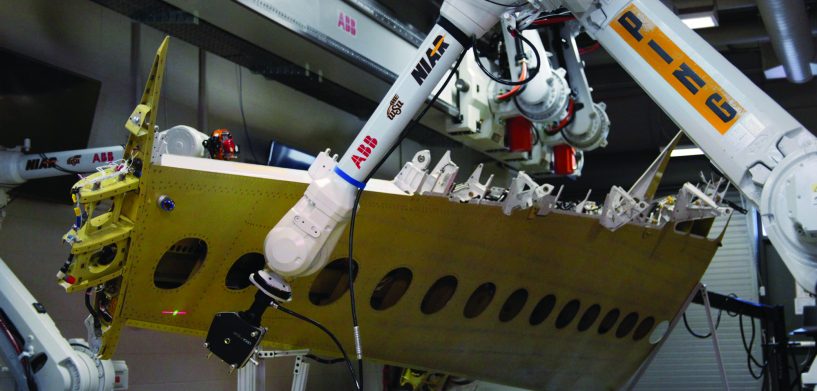BK: Welcome to HxGN Radio. My name’s Brian. Thanks for joining us today. We have Brian Brown from Wichita State University. We’re going to be discussing automating metrology and inspection. Brian, thanks for joining us.
BB: Thank you.
BK: Appreciate it. All right. So, first of all, explain metrology, and explain why the need to automate it.
BB: So, metrology deals in the measurement of parts. So it’s the science of measuring things. It’s the science of checking a part to make sure that it’s got the proper quality and make sure that it’s the proper size, proper shape, and it’s going to have all the fit, form, and function that you need to make a quality part. So essentially every single part that goes on an airplane or a car or train or automobile or anything is going to be inspected to make sure that it’s right. With that said, there’s thousands upon thousands of parts in these vehicles—
BK: Yeah, absolutely.
BB: —so the need to automate them is very strong in that you don’t want to have somebody have to measure every single part over and over and over again. So where we work in this area is we work to automate that process to make it a lot quicker and a lot more efficient as well as make it much more consistent. That way every part is being measured the exact same way, and every part is getting the exact same consistent measurement.
BK: Good, good. Okay. What about companies that have a high mix but a low-volume number of parts?
BB: So, that’s very prevalent in the aerospace industry. We don’t produce thousands of anything; we produce hundreds of things. And over the course of a lifetime, yes, we may produce 1,000, but 1,000 in an automotive market is a bad day.
BK: Sure.
BB: In any case, so, where we have a lot of high mixture of parts and a very low volume of parts, one of the things that we help people do is we help them automate that process in that we’ll do things like a car wash to where we’ll essentially come in and measure a wide array of area, and then we extract out the information that you need. So even though you’re measuring different parts all the time, you’re essentially measuring the same volume and you’re checking the same volume, and then you can extract those pieces. And that way a company that does a unique part every single day or a unique part every single hour can just throw that part in front of the measurement system and then automatically measure it, get the information they need out of it, without having to do a lot of reprogramming, without having to do a lot of work to get that new program out of it to check those parts.
BK: Okay. So, the automation process still makes a lot of sense for them, but they would think it wouldn’t necessarily, but it really helps.
BB: Yes, it does. And, again, you’re getting a very consistent measurement. So, again, if I throw a part in front of it today and I throw a part in front of it tomorrow and then I throw a part in front of it in a month from now, I’m going to have that exact same measurement process, and I’m going to have that exact same measurement come out of it whether we do it today, tomorrow, or a week from now. So the idea is I can get those consistent quality checks, which in aerospace is very important because everything we do must be approved and signed off by the FAA. So they want to make sure that we’re doing everything in a very consistent, very repeatable manner, and automation gives people that ability to have that repeatability out of their measurements and that repeatability out of the things that they do. Whether they do it in Kansas or whether they do it in Mexico or China or any other place in the world, they can get the exact same results every single time.
BK: Good. What about the companies that run arms, handheld devices, things like that?
BB: So, yeah. So there are a lot of companies that do handheld devices and they say, “But, Brian, you know, automation doesn’t really do me any good. I can’t attach a robot to my arm, I can’t attach a robot to my handheld device.” And that’s where I turn to them and say, “You know, automation isn’t always about installing a robot or isn’t always about installing some automated piece of equipment. Automation goes a long ways in that your software, whether it be SpatialAnalyser or PC-DMIS or PolyWorks or any of your software, a lot of those have the ability to automate themselves in that you can write scripts and you can write measurement plans and you can write procedures that, me as an inspection person, I can come in and follow that measurement plan, follow that script, and get that information out of it. Not only that, we can automate the series of, okay, you inspect these three areas, automatically extract this information and automatically generate this report and automatically send it to my smart quality system and automatically send it to my dashboarding systems. And the idea is now you can have those metrics and have that information automatically being fed into other systems and automatically being fed into your PLM and your data management systems, and you didn’t have to do anything. You didn’t have to do anything other than implement a little bit of programming, a little bit of scripting automation, and thus, you get a lot of benefit out of that just off of that.
BK: Absolutely. Big time efficiency.
BB: Exactly. And that’s really what it’s about is improving the efficiency, improving the quality and the consistency of the measurements that you’re getting.
BK: Good, good. Now, you’re in the aerospace and defense sector. Going back to the low-volume markets, how do you address those that fear the ROI timeline, you know, saying it’s just too long to justify dedicating a tracker to a robot, for example?
BB: And that’s exactly true. And a lot of companies are very worried about that. A lot of companies deal in very high value parts and very, very expensive parts, so they’re worried about the robot tearing things up. And what I end up telling them is, I say, “Look, when you start looking at the cost of the human doing that and the cost of errors and the cost of issues, again you are dealing with high-value part, what does it cost to scrap a single part out of that? Well, it cost thousands upon thousands, if not millions, of dollars.”
BK: Sure.
BB: “So now, your ROI really starts to pay for itself even in one saved scrapped part or one saved part.” So for these companies, I start talking to them and saying, “Look, you know, installing a robot or installing an automation system isn’t always this giant monstrosity investment that you had before. The cost of robots is coming down. The robots themselves are becoming smaller. They’re becoming to where they can be made portable. So the idea is you can now take these collaborative robots, you can put your inspection equipment on these collaborative robots that are now small, portable, movable, transportable, and then you can put them where you need them in your plant and in your shop, without having to do a lot of rework, without having to rearrange the plant, without having to do any kind of even foundation work to be able to install this automation system. So it’s not necessarily a complete disrupter of your production line. It’s an add on. It’s just like adding an extra person. It’s adding an extra set of hands. In this case, it’s adding an automation system in there that can work alongside your human workforce safely and securely and at the same time improving your efficiency, improving your quality, and improving the life of everything that’s going on around it.”
BK: Good. So you’re not putting people out of business, you know. But you really can automate quite a bit.
BB: You can automate quite a bit, and everybody always worries about over-automation and doing too much automation, and then there’s been talk in the news of companies over-automating things and that does happen. But keep in mind, we’ve gone through these types of transformations in the past, and we’ve gone through these types of disruptive technologies in the past. And what we’ve tend to find happens with them is we do become more efficient, we do become more usable in everything, and then the humans adapt, and we adapt, and we find other things to do. We find the things that the robots just can’t do, because there are a lot of things that just can’t be automated. Where I work at a university, in an R&D facility is particularly, I’ll get people that come to us and say, “Hey, can I automate this process?” And I say, “Guys, that just—with a robot, the technology just isn’t there today for that.” And unfortunately, it’s a sad point that I have to make, but there, again, there are just some things that can’t be automated, and so our human workforce is still necessary. Whether we want to be or not, we still need to be there to do a lot of different work and a lot of different tasks.
BK: But it goes back to your point of saying that it allows people—frees people up to be able to do things more—let’s even say more innovation, because they’re not doing the mundane menial tasks that, like you’re saying, automation can handle, which frees them up to do things, again like you said, robots can’t do, which creates more creativity, more innovation, probably more growth, more profit, more impact.
BB: And that’s exactly right. And even from the factory-floor worker, where they do the same thing consistently over and over and over again, that’s the part of the job that they hate. That’s the part of the job they don’t want to do. That’s why we have a shortage of manufacturing these days is because they hear, “Oh, I’ve got to do this exact same task over and over and over again—
BK: Yeah.
BB: —let me help automate that.” And part of that is inspecting parts. Sometimes it’s very boring to measure the same type of part over and over and over again. So you do hate your job. Well, guess what. Let’s let the robot do all those mundane, boring measurements, and then you do the unique, complex, and hard measurements that do make your job interesting, that do make your work interesting, that does make you feel good, that, hey, that machine wasn’t able to do it; it took me to do that. So I can come in and do those interesting and those more exciting types of tasks and those more exciting work objects.
BK: That’s exciting. It really is.
BB: It is. It is very exciting.
BK: I’m sure you’ve heard great feedback already from this.
BB: Yes, yes. And like I said, anytime we work with a company to implement automation, whether it be in metrology or other things, they always come back and say, “Man, I should’ve done this before.” Sometimes I say, “Yeah, you probably could have,” or I say, “Well, no. The technology just hasn’t been there,” especially in the world of metrology with the way Hexagon and everybody else is going. You know, things weren’t possible a few years ago even that are possible today. So, there’s more and more things that we can automate, and it’s very exciting to think about what we can automate tomorrow and the types of things that we can do tomorrow.
BK: That’s great. Well, thank you, Brian. I really appreciate this information. This has been fantastic.
BB: Not a problem. Thank you.
BK: If you want more information, obviously you can go to Hexagon Manufacturing Intelligence. Check it out! But also, if you want to see what’s going on over at Wichita State University, what Brian’s doing, you can go to NIAR—that’s spelled N-I-A-R—niar.wichita.edu. And, of course, for more episodes here at HxGN RADIO, go to hxgnspotlight.com. Thank you so much for listening, and have a great day.

















